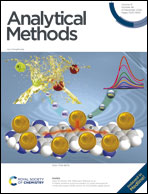Rapid single-cell detection of pathogenic bacteria for in situ determination of food safety†
Abstract
A highly sensitive in situ method to detect bacterial pathogens is of utmost importance in preventing the outbreak of foodborne diseases. In this study, a simple method enabling the detection of a single bacterial cell in a sample was developed based on magnetic capture particles (CPs), and europium-fluorescent labeling particles (LPs) functionalized with antibodies. After mixing the sample with the particles in a sample tube, the sample tube was connected to an assay chip, where the CP-bacteria–LP complex was transported from the sample chamber to a detection chamber using a simple assay device. The number of bacteria was quantitatively determined by measuring the fluorescence emitted from the detection chamber. This assay method enabled the detection of a single cell of Vibrio parahaemolyticus from 0.1 mL pure broth culture samples within 30 min. A simple enrichment method that can be performed using only the vibrating action of the assay device without any additional instruments was also developed for the analysis of food samples. By analyzing the enriched sample using the assay method, we could detect V. parahaemolyticus quantitatively with a detection limit of 1 colony forming unit from oyster samples within 130 min. Due to simplicity of this methodology and the instrumentation involved, and its capability of rapid single-cell detection, it may be considered as an in situ method for the determination of food safety.



 Please wait while we load your content...
Please wait while we load your content...